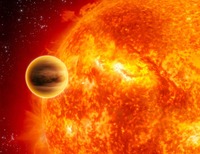







| BOOKS | F. A. Q. | ARTICLES | TALKS | ABOUT KEN | DONATE | BEYOND OUR KEN |
|---|
By Ken Croswell
Published on ScienceNOW (August 12, 2010)

Credit: Christophe Carreau/ESA.
Planning a honeymoon to a "hot Jupiter"? You might want to think again. It's bad enough that these giant planets orbit so close to their suns that they sizzle at temperatures exceeding Mercury's. But if an astronomer in France is right, you won't even have a romantic crescent to admire--because the planet probably has no moons.
Astronomers have identified hundreds of giant planets circling other stars, but they've yet to find a moon orbiting those planets. Such moons ought to exist. After all, three of the Sun's giant planets--Jupiter, Saturn, and Neptune--sport large satellites comparable in size to Earth's Moon. To detect these moons, researchers have proposed watching hot Jupiters that pass in front of, or transit, their stars. Large moons should tug the planets and thereby alter the timing of the transits.
But not so fast. "It is highly unlikely that hot Jupiters have moons that formed around them," says astronomer Fathi Namouni of the University of Nice in France. A hot Jupiter is born in the cold outer regions of its solar system and then migrates toward its star. "During this migration phase, which lasts roughly 100,000 years, the moons that form around the planet get ejected," Namouni says.
In a paper appearing in the August 20, 2010, issue of The Astrophysical Journal Letters, Namouni models a gas giant that becomes a hot Jupiter by migrating toward its star. Like Jupiter, the planet starts with four large moons; but it loses them all. As the planet approaches the star, the star's gravitational sphere of influence encroaches on the planet's, ripping away the three outermost moons and hurling them into elongated orbits around the star. The innermost moon suffers the worst fate: it crashes into the planet. The end result is a hot Jupiter that's completely moonless.
"If we observe any moons at all around a hot Jupiter," says Namouni, "these moons must have been captured later, much like Triton around Neptune." Triton is the largest captured moon in our solar system and orbits Neptune backward, a sign that the moon did not form with the planet. Namouni says a captured moon around a hot Jupiter will likely have a backward orbit, too.
Extrasolar moon hunters shouldn't despair, however, says astronomer Jason Barnes of the University of Idaho, Moscow. "There's every reason to think that searching for moons is still fruitful." Namouni's work is "technically solid," he says, but it doesn't go far enough. In particular, moons can also migrate toward their planets, ultimately crashing into them. New moons then form out of material orbiting the planet, says Barnes, a process that Namouni's work doesn't incorporate.
Astronomer David Kipping of the Harvard-Smithsonian Center for Astrophysics in Cambridge, Massachusetts, is more positive about the study. "I think Namouni has concisely demonstrated what previously had been suspected but never formally proved: that hot Jupiters are unlikely to hold onto moons during the migration process." Kipping notes that even in our solar system, the two planets nearest the Sun--Mercury and Venus--have no moons. Still, he's hopeful that NASA's Kepler spacecraft, which is designed to discover Earth-sized transiting planets, will succeed in finding extrasolar moons, because it is detecting transiting planets farther away from their stars.
Ken Croswell is an astronomer and the author of Magnificent Universe and The Lives of Stars.
"Magnificent Universe by Ken Croswell is elegant and eloquent."--Washington Post. See all reviews of Magnificent Universe here.
"A stellar picture of what we know or guess about those distant lights."--Kirkus. See all reviews of The Lives of Stars here.
| BOOKS | F. A. Q. | ARTICLES | TALKS | ABOUT KEN | DONATE | BEYOND OUR KEN |
|---|